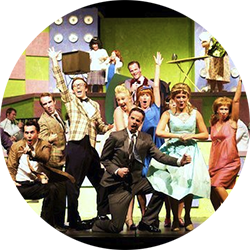SPREAD THE LOVE AROUND
Unless you teach drama in an art school like a production of Fame, we all struggle with building, growing, and sustaining our theater program and student involvement in theater productions. When I first started teaching theater full-time I was slated with many goals from the administration that included increasing student involvement in my drama courses and the after-school theater program.

Naturally, I began where most theatre educators would: I improved the quality of my productions and coursework while creating a fun and safe environment.
YES, this did help boost enrollment, but one of the most important things I did my first two years had nothing to do with what happened within the walls of the theater. It was what was happening inside the History, Art, English, and Women’s Studies classes. Thanks to some inspiring and willing colleagues, the art integration into these classes spread the unique magic of theatre arts into every corner of the school.
INTEGRATION IS LEAVING THE STATION: ALL ABOARD!
The biggest obstacle in integration can be getting teachers of other disciplines to agree to collaborate with your theater department. In the world of education where teachers already have an overload of classes, three committees they chair, and an after-school commitment coaching Varsity Pickleball, it can be a hard sell getting them to want to “take on something else.”

Anything that is perceived as, “more work”, leads to teachers sprinting away from you in the copy room. Our job is to make them see how easy it is to integrate the lesson into the curriculum they already have in place and that it is actually a small amount of work for a huge learning payoff.
DON’T SHOW UP EMPTY-HANDED
If you show up to a potluck dinner with nothing but a smile, it will likely be the last email invitation you get to the company BBQ. No one wants to work with someone who doesn’t have a plan and can’t present the ideas clearly.
Remember that you want to make the collaboration easy. Brainstorm how your class or production subject matter can integrate across curriculums ahead of time. For example, when I was producing a show about the Holocaust my first year, the art department created art for a moving lobby display leading into the theater. The History classes created projects about the Holocaust and how similar tragedies have occurred throughout the history of the world. The English classes wrote poems about the Holocaust and the winner appeared in the program. These were a few of the ideas I presented in my initial conversations followed by a timeline and dates I would need the material.
Being a clear and organized communicator allows your collaborators to focus on the educational reward for their students and not on what might appear to be, “something else on their plate.” In almost all cases the teachers were able to slightly alter upcoming lessons that already existed and eagerly get involved. It isn’t every day that a student’s work can be displayed for public viewing. It gave teacher’s an opportunity to create new and exciting lessons that students felt pride in.
To my shock and delight, it also inspired a local newspaper to come and do a story about our school’s commitment to cross-curriculum involvement for the educational benefit of the students. *Bonus points for the new theatre guy at the end of the hallway.
THE POWER OF THE ARTS
The outcome of these collaborations and the dozens that followed was that students who would normally have nothing to do with the theatre department grew to appreciate the power of the art form.

Theatre can simply be fun entertainment that allows us to escape into another world for two hours. It can also be an important tool that teaches us about our past, our present, and our future. It can make us think and ask questions about our own humanity. From the captain of the basketball team to the drama club president, students throughout the school were engaged and integrated in the same topic which culminated in the performances of the production.
There were only thirty students involved in the show, but it became a memorable experience for hundreds of students around the school. The following year my class sizes doubled and audience attendance by the student population was at an all time high, but this statistic was shadowed by the elevated learning that happened and the collaboration that was modeled to the students by their amazing teachers.
If you haven't already, be sure to check out our blog and resources for more ideas, help, tools and more to make your job of directing high school musicals a little bit easier.



Comentários